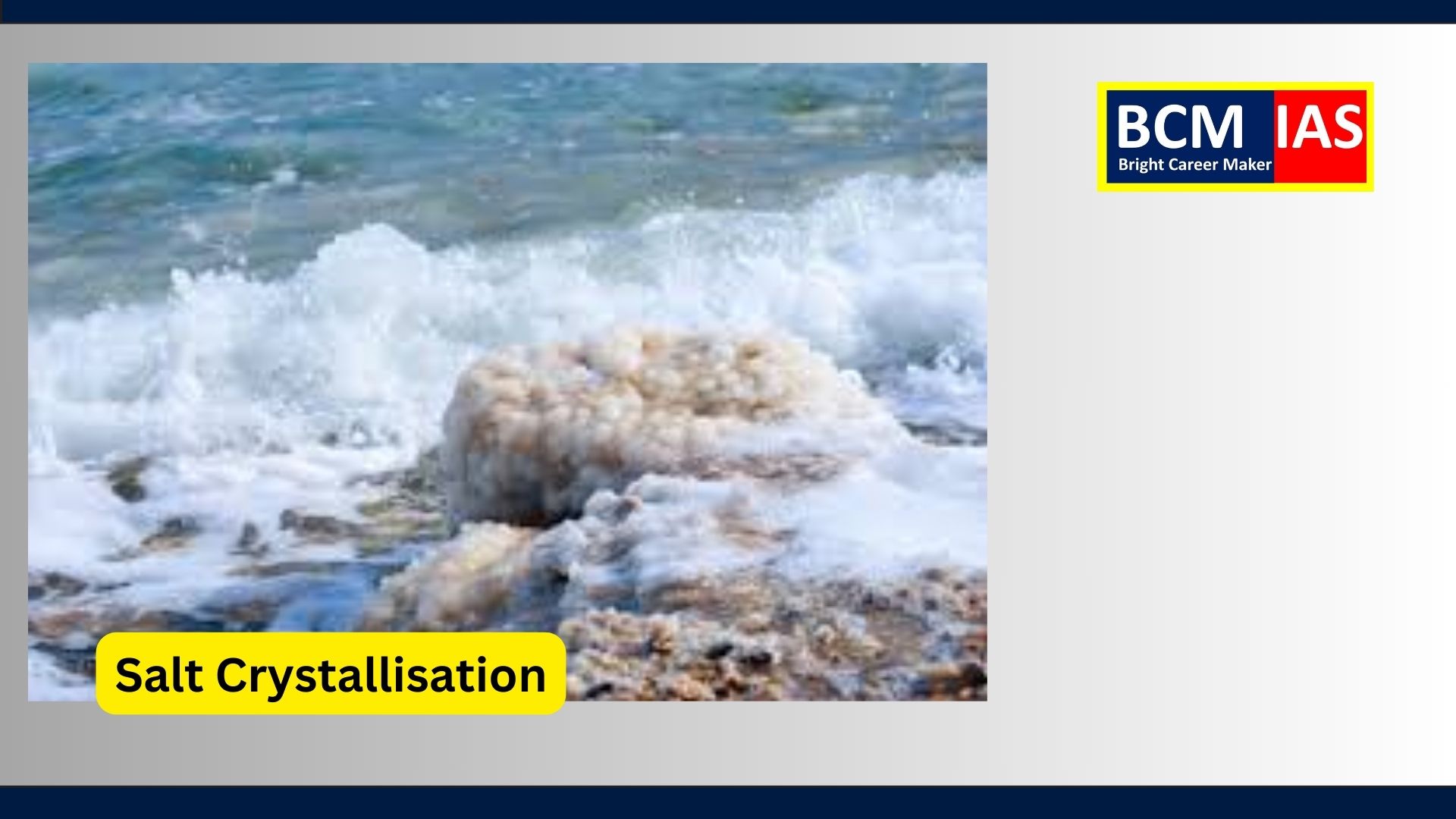
Salt Crystallisation
Analysis and Explanation
News Context
Chimney-shaped vents on the Dead
Sea floor are a unique geological phenomenon. Recently, divers have discovered
that these vents are formed through salt crystallization driven by
groundwater with extremely high salt content. This provides insights into
mineral dynamics and groundwater interactions in hyper-saline environments.
Detailed Explanation
|
Aspect |
Details |
|
Formation Process |
- Saline groundwater flows from aquifers into the saline lake sediments
of the Dead Sea. |
|
- This water leaches thick, ancient rock layers rich in halite (rock
salt). |
|
|
- The groundwater, now enriched with dissolved halite, flows upward
into the lake bed as brine. |
|
|
- Upon contact with lake water, the dissolved salts crystallize
spontaneously, forming chimney-shaped vents on the lake floor. |
|
|
Growth Characteristics |
- Vents grow rapidly, with some increasing several centimetres in a
single day. |
|
- Slender chimneys are typically 1-2 meters high, while larger ones can
exceed 7 meters in height and 2-3 meters in diameter. |
|
|
Significance |
- Highlights unique mineral crystallization processes in hypersaline
environments. |
|
- Provides clues about ancient geological processes, water-salt
dynamics, and environmental conditions in extreme habitats. |
|
|
Scientific Insight |
- Showcases the interaction between groundwater and saline lake
sediments, revealing how natural systems create geological features. |
Key Takeaways
1. Natural
Engineering: The formation of vents exemplifies nature’s ability to
engineer intricate structures through chemical and geological interactions.
2. Rapid
Crystallization: The vents demonstrate how halite can crystallize
rapidly when brine interacts with hypersaline water, creating massive
structures in a short period.
3. Research
Potential: Understanding these processes offers valuable insights for
fields like geology, hydrology, and climate studies, especially in studying
ancient salt deposits.
This discovery underscores the
unique environmental conditions of the Dead Sea and its potential as a natural
laboratory for studying extreme geological phenomena.
MCQs for Practice-
1. What is the primary mineral
responsible for the formation of chimney-shaped vents on the floor of the Dead
Sea?
(a) Gypsum
(b) Halite
(c) Quartz
(d) Calcite
Answer: (b)
Halite
2. How does the groundwater
contribute to the formation of these vents?
(a) It brings dissolved oxygen into the lake, allowing biological growth.
(b) It penetrates the lake sediments, dissolves ancient halite layers, and
emerges as brine.
(c) It erodes the lake floor, creating cavities that are later filled by
sediment.
(d) It mixes with fresh water, causing rapid chemical reactions.
Answer: (b) It
penetrates the lake sediments, dissolves ancient halite layers, and emerges as
brine.
3. Which of the following best
explains the rapid growth of the chimney-shaped vents?
(a) Accumulation of sediments brought by underwater currents.
(b) Spontaneous crystallization of dissolved salts when brine meets lake water.
(c) Deposition of volcanic ash around hydrothermal vents.
(d) Sedimentation caused by the decomposition of organic matter.
Answer: (b)
Spontaneous crystallization of dissolved salts when brine meets lake water.
4. What is the typical size of the
chimney-shaped vents on the Dead Sea floor?
(a) 10-15 meters in height with a diameter of 5-6 meters.
(b) 1-2 meters in height, but some exceed 7 meters with a diameter of 2-3
meters.
(c) Less than 1 meter in height and 1 meter in diameter.
(d) Over 20 meters in height with no diameter limit.
Answer: (b) 1-2
meters in height, but some exceed 7 meters with a diameter of 2-3 meters.
5. What triggers the
crystallization of salts in the formation of the vents?
(a) Mixing of saline groundwater with atmospheric oxygen.
(b) Evaporation of lake water near the vents.
(c) Contact of salt-rich brine with the lake’s hypersaline water.
(d) High temperatures caused by geothermal activity.
Answer: (c)
Contact of salt-rich brine with the lake’s hypersaline water.



Comments on “Salt Crystallisation”